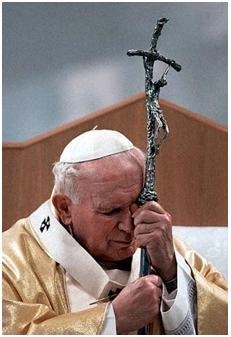 |
| Pope John Paul II holds crucifix. (http://2.bp.blogspot.com/) |
Jewish religious leader Felix Alder once said, “The hero is one who kindles a great light in the world, who sets up blazing torches in the dark streets of life for men to see by” ("Motivational and Inspirational Quotes"). Pope John Paul II, leader of the Catholic Church for almost twenty seven years, was not only an inspiration to people, but also an illumination of how one must act in the day-to-day routine branded as life. Catholics and non-Christians alike grew to love this charismatic pope because of his vast love and boundless care for everyone. He became a role model of how one should act as a human being, and in the process, he served as a hero to those who looked to him for guidance. The birth of the to-be pope was in Poland on May 18, 1920. He was the third and youngest child born to Karol Wojtyła and Emilia Kaczorowska; they named him Karol Jozef Wojtyła. At age eighteen, Karol Jozef enrolled in a theatrical school and Krakow’s Jagiellonian University; however, a year later, the school closed down due to Nazi occupation forces. To ensure his country not deport him to Germany, he worked in a quarry and chemical factory to earn his livelihood. It was around that time he began to feel God calling him to priesthood; by then, he had lost both his parents and siblings. Not allowing tragedy to get the better of him, he began taking courses in the seminary of Krakow and became a priest on November 1, 1946. He continued to study and eventually became a bishop and later a cardinal. On October 16, 1978, after the death of the current pope, the Cardinals elected Cardinal Wojtyła as the new pope. Shortly after, Cardinal Wojtyła took the name and title of Pope John Paul II. His paramount qualities made him an exceptional pope and person, and these qualities included his love of traveling and visiting citizens, no matter what religion, his insistence on Truth, and his stance on forgiveness and sacrifice. Through Pope John Paul II's remarkable spirit of love, he showed thousands of people, both Catholics and non-Christians, the light a single hero can exemplify by means compassion, confidence, and courage.
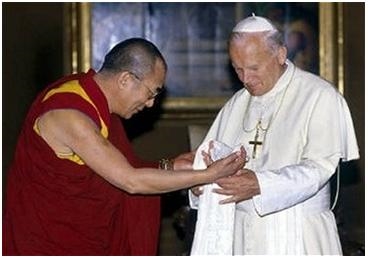 |
| Dalai Lama greets Pope John Paul II. (http://www.peacewithsoraya.org) |
Many people affectionately nicknamed Pope John Paul II the pilgrim pope because he loved to travel, and by traveling, he not only reached the Catholic citizens with his warm compassion, but he also overcame many religious barriers previously untouched by preceding popes. Unlike many other religious leaders of his position, John Paul II put a great deal of time into visiting the people who looked to him for guidance in their religious lives: "Driven by his pastoral solicitude for all Churches and by a sense of openness and charity to the entire human race, John Paul II exercised the Petrine ministry with a tireless missionary spirit, dedicating it all his energy. He made 104 pastoral visits outside Italy and 146 within Italy. As bishop of Rome he visited 317 of the city's 333 parishes" ("His Holiness John Paul II "). John Paul II traveled as a way to spread his message of love and faith to all he could reach. He drew near to people instead of insisting the people come to him so that he could be among the ordinary of everyday life instead of in his high Vatican post off in the abstract. Pope John Paul II also insisted on the communication of different religions: "He has broken many religious barriers, promoting an interfaith dialogue previously unknown in the Catholic Church" ("John Paul II"). The word "Catholic" means "universal", and this pope understood how there had to be unity with other religions for people to be able to grow in their faith. His love was for anyone; to him, it did not matter if someone had a different religion. Instead of thinking of himself better than others who held different beliefs, he overlooked differences and came to the conclusion that humans are humans and every individual needs love. While the pope loved the Catholic people and visited them much more frequently than any of the other previous popes, he also insisted different religions push aside their disagreements and treat each other with the same love and respect as they would treat someone of their own religion.
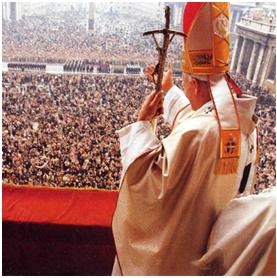 |
| The Pope stands before thousands of people. (http://www.jesuschristsavior.net/JohnPaul.jpeg ) |
Time cradled Pope John Paul II's papacy in a moment where new ideas began to replace old customs, but he maintained himself firm in the truth. While many people began to consider new ideas such as sex before marriage and abortion, John Paul II's confidence in his beliefs kept him strong as a leader; New Yorker once quoted him saying: "You cannot take a vote on the Truth. You cannot pick and choose" (Stanley). In the Catholic Church, there is the belief that God does not change, and, in a way, the pope viewed Truth as part of God and did not believe Truth changed either. This reveals the pope's commitment to his religion because he had the power to change some of those rules but refused because he simply believed it was not right. He also maintained himself rooted in the Truth that God fashions all human beings as equals: "The pope has worked to bring change to the papal government—the Vatican—by appointing many Africans, Americans, and Northern Europeans to high Vatican posts" ("John Paul II"). John Paul II was not one who discriminated against races. He no doubt had an open heart to all individuals, no matter where they came from. His desire for everyone to work with and for God evidently showed through his insistence that people from different backgrounds should work in the Vatican. Although many ideas erupted around John Paul II during his papacy, he gravitated around truth and justice like a planet to the sun and didn't discriminate against anyone.
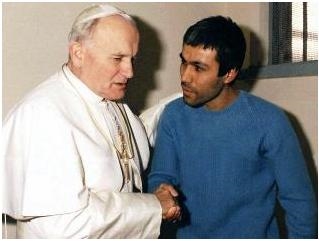 |
| Pope John Paul II forgives his attempted killer. (http://resources2.news.com.au/) |
Of all the things that made Pope John Paul II great, possibly the most moving was his infinite willingness to forgive and sacrifice. One quality fictional heroes almost always lack is forgiveness. While childhood superheroes such as Batman, Wonder Woman, and Superman always plotted against “the bad guy” with violence and condemnation, a true hero does not judge anyone—even someone who attempted murder against him: “’What we talked about will have to remain a secret between him and me,’ the Pope said as he emerged from the cell. ‘I spoke to him as a brother whom I have pardoned, and who has my complete trust.’ As John Paul rose to leave, the two men shook hands. The Pope gave Agca, who will turn 26 next week, a small gift in a white box, a rosary in silver and mother-of-pearl. The Pope walked out. Agca was left standing alone, and the camera recorded a sudden look of uncertainty on his face. Perhaps he was thinking about the prospect of spending the rest of his life in jail for attempting to kill a man he did not know, a man who now came to him as a friend” (Morrow, 1984). It takes an incredible amount of courage to forgive something of that magnitude, and Pope John Paul II did not only forgive the man who tried to shoot him, but he accepted him as a “brother”. This amount of love is very, very rarely heard of. It resembles the love Christians believed God has for them—surpassing every boundary of what is expected or deserved. John Paul II embodied the form of a human, but within him, his spirit radiated a pureness only heroes contain. Another Christian belief Catholics hold is that Jesus Christ carried a cross holding all of the world's sins, and in a way, John Paul II also accepted the burden of sacrifice: "Although struggling with Parkinson's disease, John Paul continued to travel, although he could no longer walk and sometimes had difficulty speaking" ("John Paul II"). It is evident the pope was resolute in working the hardest he could to keep spreading the faith in the time left for him to live. Instead of taking things slow for a while, he maintained his zeal. When one is under pain and has difficulty doing what once came so easily, temptation to give up will arouse, but the pope courageously continued to do what he loved. Pope John Paul II's stance on forgiveness and sacrifice was unyielding, even at the presence of a man who tried murdering him and through the complications of old age; throughout all his life, the strength of John Paul’s spirit overcame all obstacles.
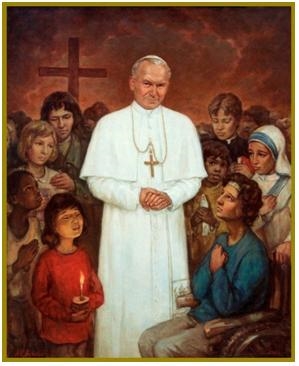 |
| Pope John Paul II is surrounded by a crowd. (http://babailov.homestead.com/) |
A strong and indubitable man, a product of the deepest heroic traits, John Paul II acted from love to anyone put in his path. Although he was the leader of the Catholic Church, the fact that someone wasn't part of his religion didn't dim his love for them. He maintained truth when he could have fallen into the trap of indulgence, and he showed his courage through his willingness to forgive and endure pain. Pope John Paul II is a light of inspiration to everyone because, although he didn't always have the easiest life, he didn’t let anything bring him down. He did what he loved--traveling and speaking--all of his life, accepting challenges as ways to become stronger. His voyage through life proved there is more we can all do to light the path for others by standing firm in one’s beliefs and loving others with our entire hearts. He accepted his calling with grace and persistence, and we, too, must accept our calling, “set our blazing torches”, and light the darkness for all to see the beam of brightness within us.
Page created on 7/25/2012 12:30:45 PM
Last edited 4/22/2020 2:15:20 AM
Boylan, Kristina A. "John Paul II, Pope (1920–2005)." Encyclopedia of Latin American History and Culture. Ed. Jay Kinsbruner and Erick D. Langer. 2nd ed. Vol. 4. Detroit: Charles Scribner's Sons, 2008. 40-41. Gale Virtual Reference Library. Web. 14 Dec. 2010.
Colquhoun , Robert. "Top ten moments in the life of Pope John Paul II (JP2)." Discover Happiness. N.p., 07/21/2009. Web. 10 Jan 2011.
"Felix Alder." (2010): n. pag. Web. 10 Jan 2011. Granfield, Patrick. "Papacy." Encyclopedia of Religion. Ed. Lindsay Jones. 2nd ed. Vol. 10.
Detroit: Macmillan Reference USA, 2005. 6965-6976. Gale Virtual Reference Library. Web. 14 Dec. 2010.
"His Holiness John Paul II ." vatican.va. Holy See Press Office, 30.06.2005. Web. 17 Dec 2010.
"John Paul II." U*X*L Biographies. Detroit: U*X*L, 2003. Gale Student Resources In Context. Web. 13 Dec. 2010.
"Life and Living." iwise.com. iWise Inc., 2011. Web. 6 Jan 2011.
Morrow, Lance. "Pope John Paul II Forgives His Would-Be Assassin." (1984): n. pag. Web. 10 Jan 2011.
"Motivational and Inspirational Quotes." Motivational and Inspirational Corner, America's System for Success. Power Performance, 2002-2003. Web. 10 Jan 2011.
"Pope John Paul II biographer lectures on his legacy." Gazette [Colorado Springs, CO] 21 Feb. 2010. Gale Student Resources In Context. Web. 14 Dec. 2010.
"Pope John Paul II Quotes." Brainy Quote. N.p., 2001-2011. Web. 10 Jan 2011.
Stanley, Alessandra. "Pope asks forgiveness for errors of church; In a historic Mass, John Paul II apologizes for sins committed throughout history of Catholicism." Austin American-Statesman [TX] 13 Mar. 2000: A1. Global Issues In Context. Web. 13 Dec. 2010.
